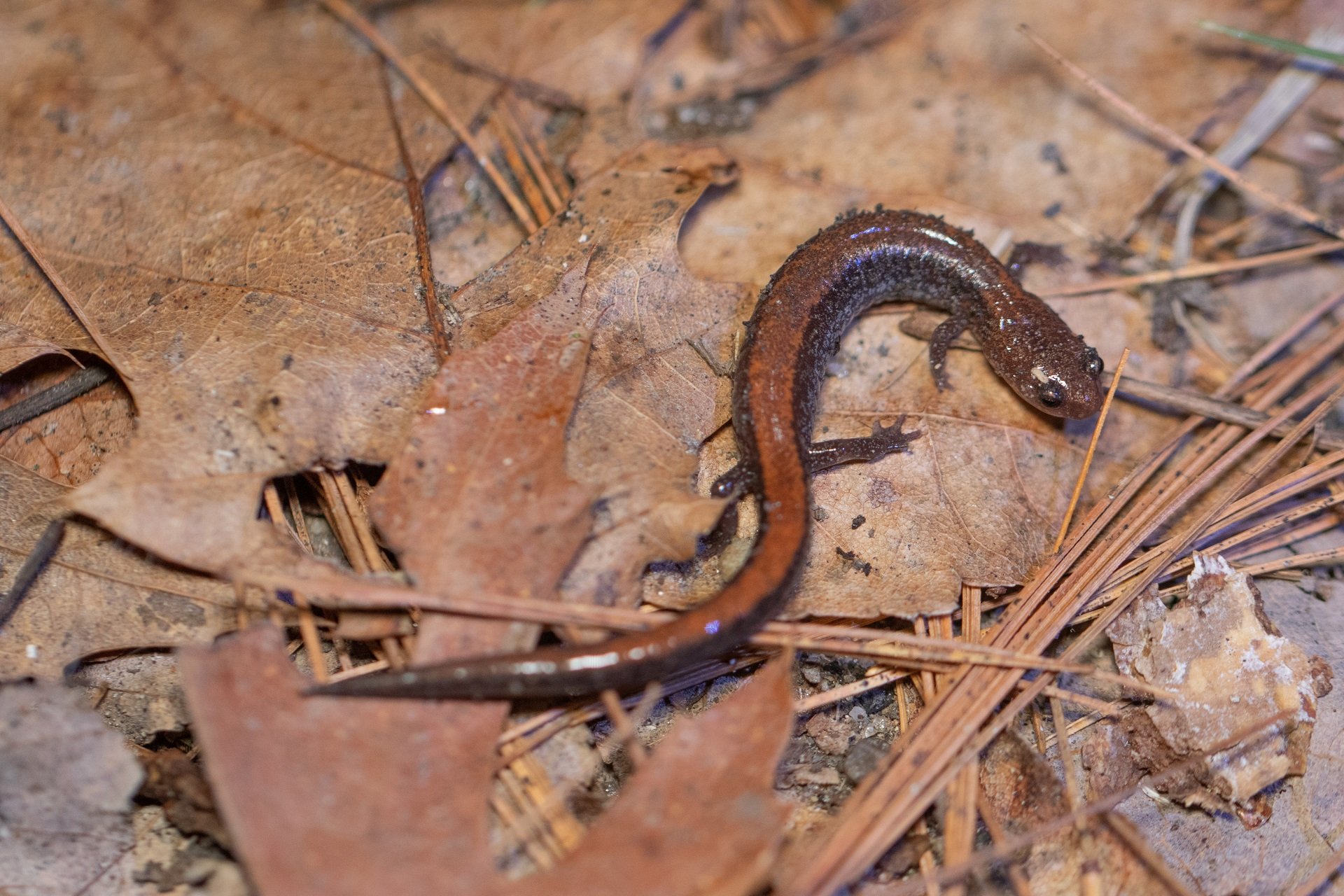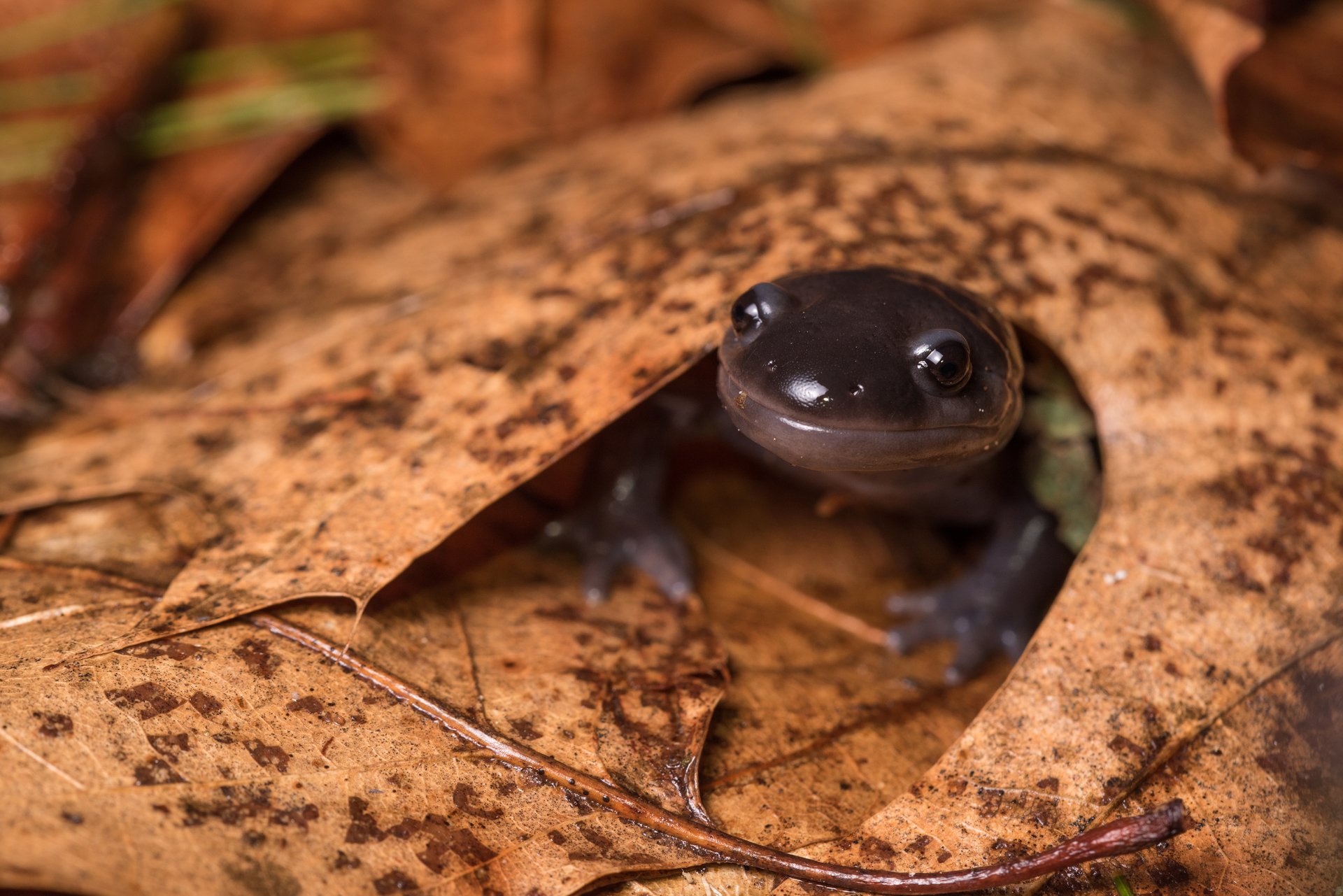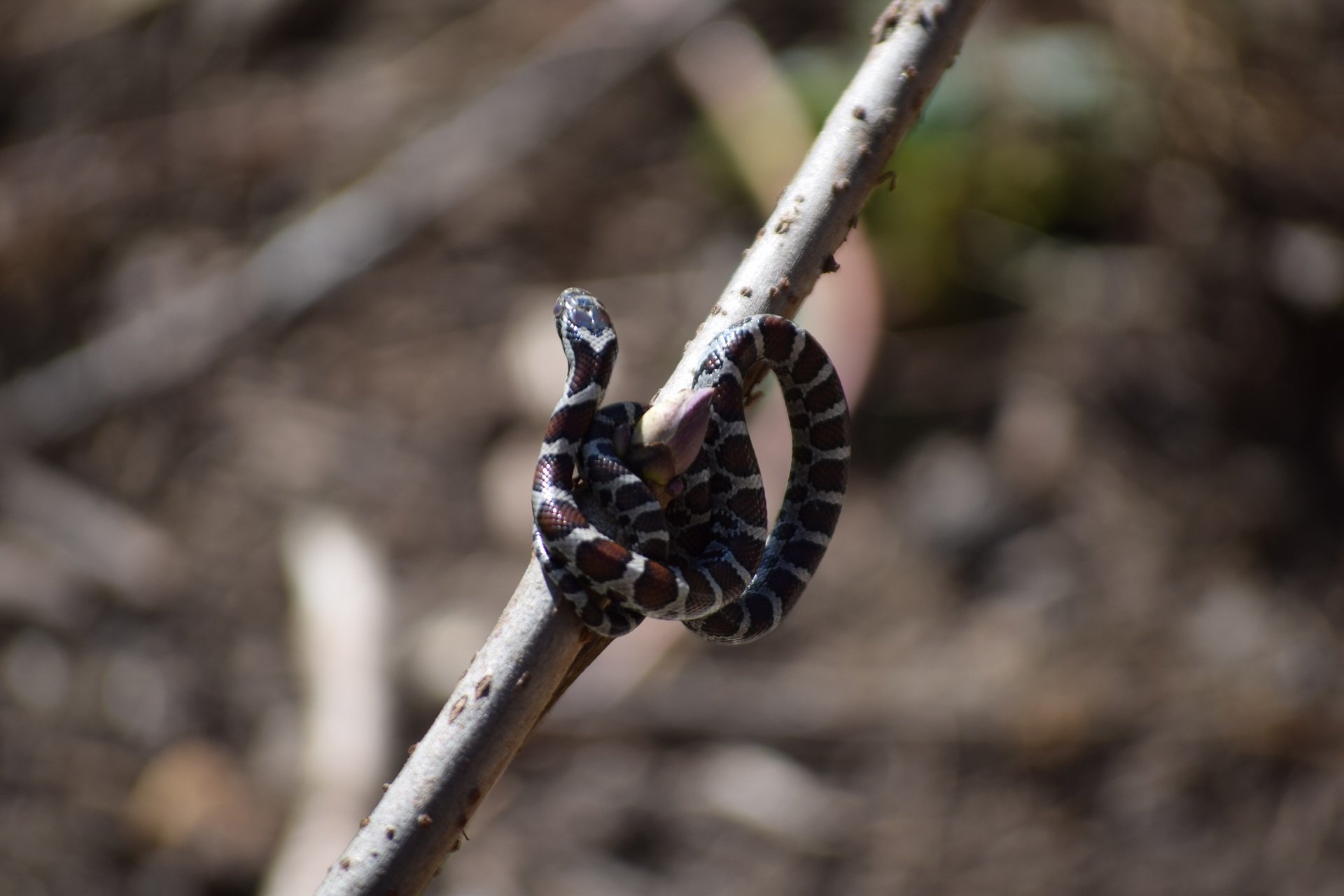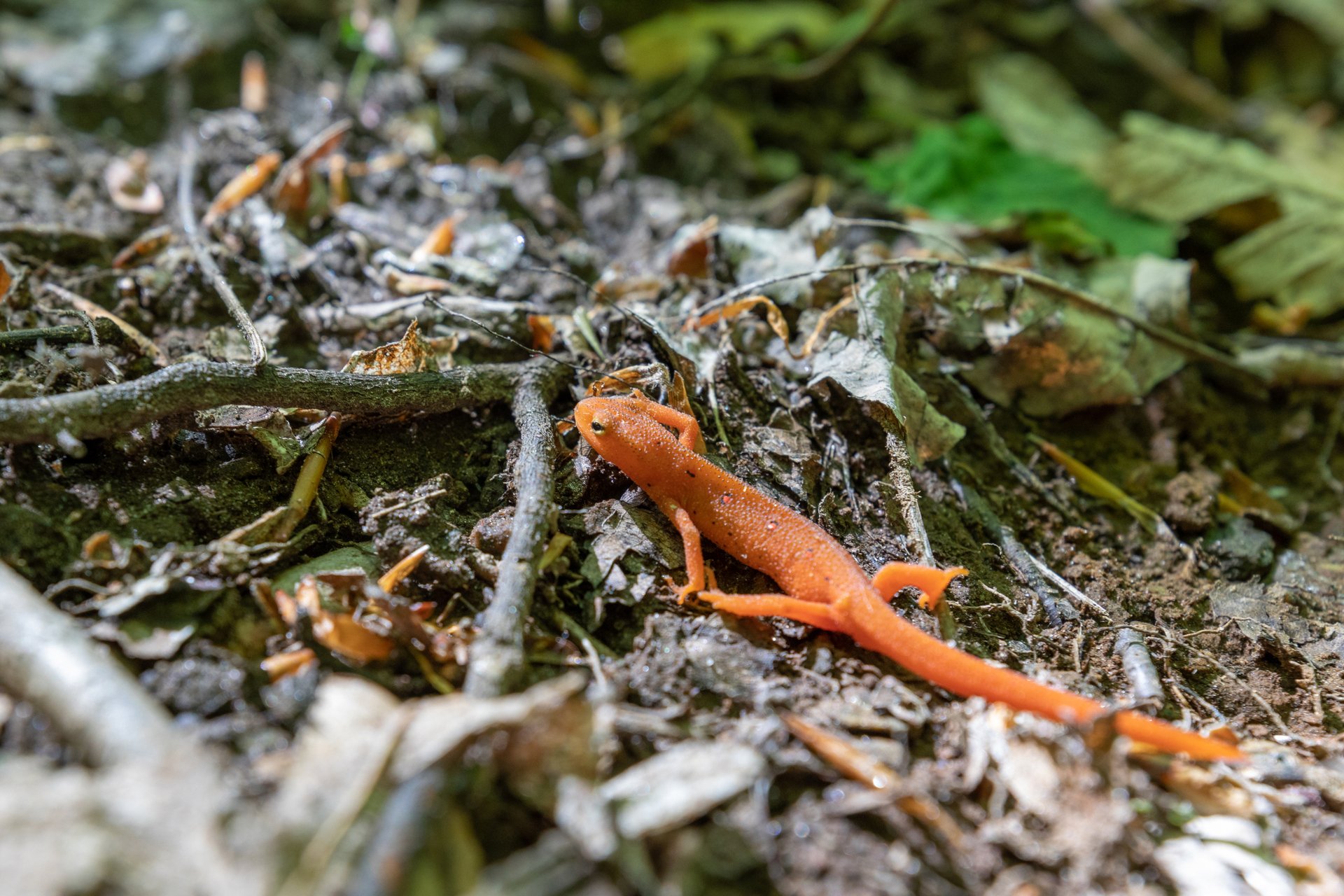Reptiles & Amphibians
Salamanders
Salamanders are so secretive that most people never encounter them! But because of their sensitive skin and specific habitat requirements, these shy creatures can tell us a lot about the health of our environment.
All salamanders belong to the amphibian order Caudata, from the Latin word for "tailed." Newts and mudpuppies are also types of salamanders.
Because of their slender bodies and long tails, salamanders look somewhat like lizards, so people often confuse the two. But lizards are reptiles, whereas salamanders are amphibians like frogs and toads. Lizards have scales and claws; salamanders do not. Lizards typically have dry skin; most salamanders stay moist, and many of them use their wet skin as a surface through which to breathe.
Salamander Species in Massachusetts
There are 11 species of salamanders in Massachusetts. They belong to four scientific families—lungless salamanders, mole salamanders, newts, and mudpuppies—and come in a dizzying array of colors and patterns.
Eastern Red-backed Salamander (Plethodon cinereus)
This small salamander may be the most abundant vertebrate (backboned animal) in the northeast, and it’s found all across the state. It is lungless, and breathes through its moist skin. Despite its name, its color varies; it’s often gray with a red stripe down its back, but it may be entirely red or entirely gray. Its belly is finely speckled with white and gray. Unlike our other salamanders, it spends its entire life on land and lays its eggs on the moist forest floor. The young skip the typical aquatic stage and emerge as tiny terrestrial salamanders.
Four-toed Salamander (Hemidactylium scutatum)
Another lungless salamander, this relatively uncommon species is the only one in our area with four toes on its hind feet (rather than five). Its back is a mix of rusty-brown and gray-blue, and its underside is white with large black flecks. It lives under cover on the floor of hardwood forests, and breeds in boggy areas, attaching its eggs to vegetation and guarding them until they hatch.
Northern Two-lined Salamander (Eurycea bislineata)
This sleek, speedy lungless salamander is often found in forest streams across the state. It has a copper to yellow back, a yellow belly, and two black stripes running down its sides. After males and females take part in an elaborate courtship dance, the females attach eggs to the undersides of rocks in water bodies and protect them until they hatch.
Northern Dusky Salamander (Desmognathus fuscus)
A chunkier lungless salamander, it tends to live in and near streams and seeps, and is found in the central and western parts of Massachusetts. Its hind legs are noticeably thicker than its front legs. A light-colored line runs from its eye to its chin. It lays its eggs under moss and protects them from predators.
Northern Spring Salamander (Gyrinophilus porphyriticus)
This larger lungless salamander can grow 8–9 inches long. It's pinkish or reddish in color, with dark mottling. A light-colored line runs from its eye to its nose. A swift swimmer, it prefers clean, cold streams and lays its eggs under rocks in water. It’s found in the central and western parts of Massachusetts.
Spotted Salamander (Ambystoma maculatum)
Like other mole salamanders, the Spotted Salamander spends most of its year in the forest, under cover or in small mammal burrows underground. It emerges in the spring to breed in vernal pools, producing large jelly-like egg masses of 100-300 eggs and attaching them to twigs or rocks in a pool. This salamander can grow up to 9 inches long and live for more than 20 years. No other species in our state has large yellow spots!
Jefferson Salamander (Ambystoma jeffersonianum)
This mole salamander is grey-brown and may have small white or blue flecks. Its toes are long and it has a relatively long snout. Like the Spotted Salamander, it breeds in vernal pools. It’s found in the western part of the state.
Status: Listed as "Special Concern" under the Massachusetts Endangered Species Act. It’s illegal to kill, harass, collect, or possess this salamander.
Blue-spotted Salamander (Ambystoma laterale)
Another mole salamander, this species has shorter toes and a rounder snout. As its name indicates, it has a variable pattern of blue spots. It’s found in the central and eastern parts of the state.
Status: Listed as "Special Concern" under the Massachusetts Endangered Species Act. It's illegal to kill, harass, collect, or possess this salamander.
[Hybrid] Blue-spotted x Jefferson Salamanders
Some salamanders may look like a mix between the Blue-spotted Salamander and the Jefferson Salamander. These belong to a fascinating all-female population with genetic material from both species, and its members are able to reproduce without fertilization.
Marbled Salamander (Ambystoma opacum)
Rare mole salamander in Massachusetts. Reaching only ~4 inches in length, it's black with large silvery stripes and blotches, which are whiter in males and grayer in females. Unlike other mole salamanders, it breeds in the fall and lays its eggs in depressions where vernal pools will later appear. These eggs can hatch as soon as the rains come in the late fall or early winter, giving young marbled salamanders a head start over other species.
Status: Listed as "Threatened" under the Massachusetts Endangered Species Act. It's illegal to kill, harass, or possess this salamander.
Eastern Newt (Notophthalmus viridescens)
This species is found nearly statewide, and it has an unusual three-part life cycle. An Eastern Newt begins life as a fully aquatic creature with visible gills, then enters a terrestrial bright orange stage called a "Red Eft" (often encountered by hikers), and finally returns to the water as a yellow and green adult. To pass through these stages successfully, the Eastern Newt needs wetlands that are adjacent to forests.
Mudpuppy (Necturus maculosus)
At up to 15 inches long, the Mudpuppy is by far our largest salamander. It’s mud-colored and, since it's remains aquatic throughout its lifestyle, has feathery external gills. In Massachusetts it's only found in the Connecticut River, and was likely introduced to the area from elsewhere.
Behavior
Unlike frogs, salamanders are rarely vocal. Instead, they communicate using touch and chemicals. To avoid predators, they may exude bad-tasting substances. Some advertise their poisonous nature with bright colors.
For example, hikers often encounter apparently defenseless orange salamanders walking on the forest floor. These are Eastern Newts in their juvenile stage (known as Red Efts), and they're extremely poisonous to eat.
Food
Salamanders eat many small animals, from insects to spiders to worms. They consume several creatures that people consider pests including slugs, mosquito larvae, and flies. They will also sometimes eat other salamanders.
Life Cycle
There’s a great deal of variety in salamander life cycles. They live and breed in various types of water bodies or on the forest floor, and their life cycles may encompass more than one of these habitats.
Several Massachusetts salamander species migrate from their overwintering spots in wooded upland areas to breed in vernal pools during a phenomenon known as "Big Night". Vernal pools are temporary ponds created by spring rains and snow melts. They dry up by mid-summer, which makes them inhospitable to predators such as fish. Learn more about vernal pools
In most salamander species, breeding involves the male placing a sperm packet called a spermatophore on the ground or on debris in a pool. The female inserts it into her cloaca to fertilize her eggs, which she may attach to sticks and leaves or under rocks. Some species guard their eggs from predators until they hatch.
Many young salamanders go through an aquatic tadpole stage in which they have visible feathery gills. When they become adults, they may lose gills and gain eyelids and a tongue, as well as the ability to walk on land.
Salamander Threats & Conservation
Amphibians all around the world are in trouble. Of the 11 salamander species in the state, three are listed under the MA Endangered Species Act. They face several dangers throughout their lives, and many salamanders perish when they cross roads to reach their breeding pools. Loss of habitat is another major threat.
Salamanders Crossing Roads
Some salamander species emerge from their underground wintering sites to migrate to their breeding pools—temporary water bodies called vernal pools. This annual salamander migration is an exciting spectacle, and usually happens in late winter or early spring on the first rainy night over 45 degrees Fahrenheit.
Unfortunately, many of our roads pass between those upland wintering sites and lowland vernal pools. This causes significant salamander road mortality.
How You Can Help
Support the creation of special tunnels called "amphibian migration corridors" (or "salamander tunnels") that allow these creatures to cross safely under roadways. Many towns close specific roads on the first warm rainy nights of spring.
You can also help by joining a local volunteer program in which people physically carry salamanders across roads, often while collecting important scientific data!
Loss of Habitat
Many salamanders inhabit very specific habitats—from vernal pools to sphagnum bogs to forests—and need to travel between different habitats throughout their lives. For that reason, habitat loss and degradation is a serious threat to all salamander species.
Additionally, salamanders have porous, sensitive skin that readily absorbs toxins. That means poor water quality due to acid rain, pollution, and pesticides can negatively impact their survival.
How You Can Help
Contact your local elected officials and ask them to support local wetland bylaws in your town that afford more protection to vernal pools. In addition, you can support efforts to define and preserve other critical salamander habitat.
Unprotected Vernal Pools
Vernal pools are a severely threatened resource in the Commonwealth. But because they only exist for part of the year, many are overlooked when wetlands are identified and certified. These isolated, uncertified vernal pools therefore don't receive protection under the Massachusetts Wetland Protection Act.
How You Can Help
Certification is one of the best ways to protect these severely threatened resources—and you can make it happen! To get a vernal pool certified as wildlife habitat, you'll need to gather some information and submit it to MassWildlife's Natural Heritage & Endangered Species Program (NHESP). Here's how:
- Locate a potential vernal pool—but remember to secure permission from landowners before undertaking exploratory hikes!
- Register for an account on the NHESP Heritage Hub, the state's reporting and filing system that allows anyone to report vernal pools.
- Follow the Heritage Hub vernal pool certification guidelines to submit your observation.
Stay Connected
Don't miss a beat on all the ways you can get outdoors, celebrate nature, and get involved.






